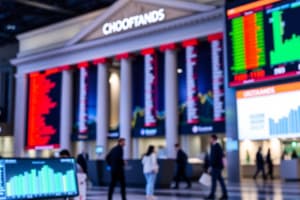Podcast
Questions and Answers
In the regression equation ri,t rf = g0 + g1 (rM,t rf ) + g2 SM Bt + ei,t, if the CAPM is true, what would you expect the estimated coefficient g1 to represent?
In the regression equation ri,t rf = g0 + g1 (rM,t rf ) + g2 SM Bt + ei,t, if the CAPM is true, what would you expect the estimated coefficient g1 to represent?
- None of the answers are correct
- The risk-free rate
- The size factor
- The market risk premium (correct)
- The average return on small size firms
If a single index model has been estimated for stocks A and B with the following results: $rA,t rf = 0.01 + 0.6(rM,t rf) + eA,t$, $rB,t rf = 0.02 + 0.9(rM,t rf) + eB,t$. Also, SD measures of $rM$, $eA$, and $eB$ are 0.25, 0.1, and 0.2, respectively. What is the covariance between the returns on stocks A and B?
If a single index model has been estimated for stocks A and B with the following results: $rA,t rf = 0.01 + 0.6(rM,t rf) + eA,t$, $rB,t rf = 0.02 + 0.9(rM,t rf) + eB,t$. Also, SD measures of $rM$, $eA$, and $eB$ are 0.25, 0.1, and 0.2, respectively. What is the covariance between the returns on stocks A and B?
- 0.0050
- None of the answers are correct
- 0.0525
- 0.1920
- 0.0338 (correct)
In the context of the single index model, if the coefficient of the market return for stock A is 0.6 and the standard deviation of the market return is 0.25, what does the coefficient value imply?
In the context of the single index model, if the coefficient of the market return for stock A is 0.6 and the standard deviation of the market return is 0.25, what does the coefficient value imply?
- Stock A has a higher average return than the market
- Stock A is less sensitive to market movements (correct)
- Stock A is more sensitive to market movements
- None of the answers are correct
- Stock A has a lower average return than the market
If the CAPM is true, what would you expect the estimated coefficient g2 in the regression equation $ri,t rf = g0 + g1 (rM,t rf) + g2 SM Bt + ei,t$ to represent?
If the CAPM is true, what would you expect the estimated coefficient g2 in the regression equation $ri,t rf = g0 + g1 (rM,t rf) + g2 SM Bt + ei,t$ to represent?
If the single index model has been estimated for stocks A and B with the following results: $rA,t rf = 0.01 + 0.6(rM,t rf) + eA,t$, $rB,t rf = 0.02 + 0.9(rM,t rf) + eB,t$. Also, SD measures of $rM$, $eA$, and $eB$ are 0.25, 0.1, and 0.2, respectively. What is the correlation coefficient between the returns on stocks A and B?
If the single index model has been estimated for stocks A and B with the following results: $rA,t rf = 0.01 + 0.6(rM,t rf) + eA,t$, $rB,t rf = 0.02 + 0.9(rM,t rf) + eB,t$. Also, SD measures of $rM$, $eA$, and $eB$ are 0.25, 0.1, and 0.2, respectively. What is the correlation coefficient between the returns on stocks A and B?
In the single index model, if the coefficient of the market return for stock A is 0.6 and the standard deviation of the market return is 0.25, what does the coefficient value imply?
In the single index model, if the coefficient of the market return for stock A is 0.6 and the standard deviation of the market return is 0.25, what does the coefficient value imply?
If the CAPM is true, what would you expect the estimated coefficient g2 in the regression equation $ri,t rf = g0 + g1 (rM,t rf) + g2 SM Bt + ei,t$ to represent?
If the CAPM is true, what would you expect the estimated coefficient g2 in the regression equation $ri,t rf = g0 + g1 (rM,t rf) + g2 SM Bt + ei,t$ to represent?
What is the correlation coefficient between the returns on stocks A and B, given the single index model results: $rA,t rf = 0.01 + 0.6(rM,t rf) + eA,t$, $rB,t rf = 0.02 + 0.9(rM,t rf) + eB,t$ and SD measures of $rM$, $eA$, and $eB$ are 0.25, 0.1, and 0.2, respectively?
What is the correlation coefficient between the returns on stocks A and B, given the single index model results: $rA,t rf = 0.01 + 0.6(rM,t rf) + eA,t$, $rB,t rf = 0.02 + 0.9(rM,t rf) + eB,t$ and SD measures of $rM$, $eA$, and $eB$ are 0.25, 0.1, and 0.2, respectively?
If the single index model has been estimated for stocks A and B, what is the covariance between the returns on stocks A and B, given the regression results and SD measures?
If the single index model has been estimated for stocks A and B, what is the covariance between the returns on stocks A and B, given the regression results and SD measures?
If the single index model has been estimated for stocks A and B, and the standard deviation measures of $rM$, $eA$, and $eB$ are 0.25, 0.1, and 0.2, respectively, what does the covariance between the returns on stocks A and B indicate?
If the single index model has been estimated for stocks A and B, and the standard deviation measures of $rM$, $eA$, and $eB$ are 0.25, 0.1, and 0.2, respectively, what does the covariance between the returns on stocks A and B indicate?
Flashcards are hidden until you start studying




